Related Research Articles
In railway engineering, "gauge" is the transverse distance between the inner surfaces of the heads of two rails, which for the vast majority of railway lines is the number of rails in place. However, it is sometimes necessary for track to carry railway vehicles with wheels matched to two different gauges. Such track is described as dual gauge – achieved either by addition of a third rail, if it will fit, or by two additional rails. Dual-gauge tracks are more expensive to configure with signals and sidings, and to maintain, than two separate single-gauge tracks. It is therefore usual to build dual-gauge or other multi-gauge tracks only when necessitated by lack of space or when tracks of two different gauges meet in marshalling yards or passenger stations. Dual-gauge tracks are by far the most common configuration, but triple-gauge tracks have been built in some situations.

The Sandridge Bridge is a historic bridge, which originally carried railway lines over the Yarra River in Melbourne, Victoria, Australia. It runs diagonally to the river and is 178.4 metres (585 ft) long. In 2006, it was redeveloped as a pedestrian and cycle path, featuring public art. It is the third bridge on the site and is listed on the Victorian Heritage Register.
Railway Digest is a monthly magazine, published in Sydney, covering contemporary railways of Australia.
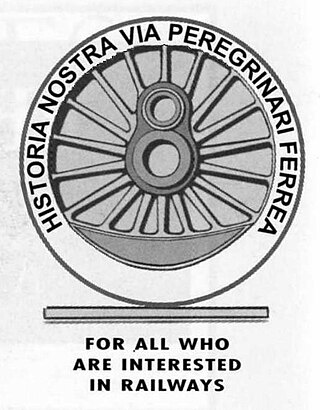
The Australian Railway Historical Society (ARHS) aims to foster an interest in the railways, and record and preserve many facets of railway operations. It has had divisions in every state and the Australian Capital Territory, although the ACT division was wound up in 2016, along with the Victorian division in 2020. Since 1967, when each division incorporated, the state divisions have operated as separate entities. Each still trades under the ARHS brand, except in Western Australia, where the division is called Rail Heritage WA. Individual membership exceeds 2,500.

The Australian Standard Garratt (ASG) was a Garratt locomotive designed in Australia during World War II, and used on 3 ft 6 in narrow gauge railway systems in Queensland, South Australia, Western Australia and Tasmania.
The Port Melbourne railway line is a former railway line in Melbourne, Australia, opened in September 1854, that is now a light rail line. It was instigated by the Melbourne and Hobson's Bay Railway Company to carry passengers arriving in Victoria at Station Pier and to alleviate the high cost of shipping goods using small vessels up the Yarra River to Melbourne. The line's conversion to light rail occurred in 1987; it is now served by tram route 109.

The Spirit of Progress was the premier express passenger train on the Victorian Railways in Australia, running from Melbourne to the New South Wales border at Albury, and later through to Sydney.

The Main Suburban railway line is the technical name for the trunk railway line between Redfern railway station and Parramatta railway station in Sydney, Australia, but now generally refers to the section between Redfern and where the Old Main South Line branches off at Granville Junction. The railway line then continues on as the Main Western line towards the Blue Mountains. This term distinguished this trunk line from the Illawarra Line which branched south from the Illawarra Junction to Wollongong, and later the North Shore line which carried trains north over the Harbour Bridge.

The Kerang–Koondrook Tramway was an Australian private railway of 5 ft 3 in broad gauge, running from Kerang station, on the state-owned Victorian Railways Piangil railway line, to the Murray River town of Koondrook, with intermediate stations at Yeoburn, Hinksons, Teal Point and Gannawarra.

The Old Ghan Heritage Railway and Museum is an Australian railway museum in Alice Springs, in the Northern Territory. It was attached to a narrow-gauge tourist railway line, now closed. The Road Transport Historical Society, which also owns the adjacent National Road Transport Hall of Fame, operates the museum.

The 43 class were a class of Australian diesel locomotives built by A Goninan & Co, Broadmeadow for the New South Wales Department of Railways in 1956–1957.

The Z18 class was a class consisting of six 0-6-0T steam tank locomotives built by Vulcan Foundry for the New South Wales Government Railways of Australia.

The South Australian Railways 930 class was a class of diesel-electric locomotives built for the South Australian Railways between 1955 and 1967 by AE Goodwin, Auburn, New South Wales, the Australian licensee of the American Locomotive Company (Alco). Based on the Alco DL500B World series model, they were fitted with Alco 12-251B four-stroke V12 turbocharged diesel engines that developed 1600 horsepower for traction. The first six of the class had a driving cab at one end only; the remaining 31 locomotives had two. The latter series, up-rated, were the basis of the almost identical New South Wales 44 class, of which 100 were built from 1957.
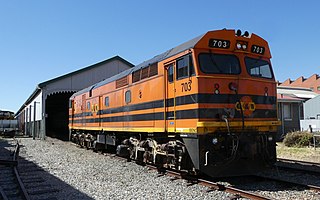
The 700 class is a class of six diesel-electric locomotives based on the Alco DL500G model, built by AE Goodwin, Auburn, New South Wales for the South Australian Railways. They are virtually identical to the New South Wales 442 class locomotive.

The South Australian Railways Y class was a class of narrow gauge steam locomotives operated by the South Australian Railways.
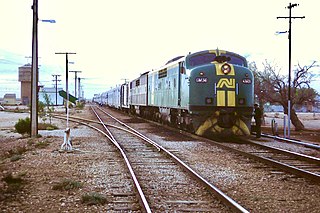
The Trans-Australian was an Australian passenger train operated by the Commonwealth Railways initially between Port Augusta and Kalgoorlie on the Trans-Australian Railway line, and later extended west to Perth, and east to Port Pirie and Adelaide.

Melbourne and Hobson's Bay Railway Company 2-2-2WT (1854) was the first locomotive operated after the inauguration of a public railway line in Australia. It had 7+7⁄8 in (200 mm) diameter cylinders and was capable of producing 30.0 horsepower, reaching 25 mph (40 km/h) and hauling 130 tonnes.
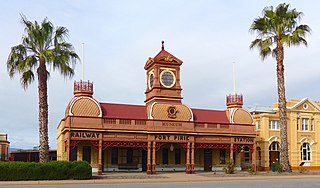
Ellen Street railway station was the second of six stations that operated successively between 1875 and the early 2010s to serve the rural maritime town of Port Pirie, 216 km (134 mi) by rail north of Adelaide, South Australia. Soon after construction of the line towards Gladstone began in 1875, an impromptu passenger service commenced. The inaugural station, Port Pirie South, was 800 metres from the centre of the town. Since two tracks had already been laid down the middle of Ellen Street to the wharves, a small corrugated iron shed was erected as a ticket and parcels office. The street-side location was unusual for the South Australian Railways. In 1902, when passenger traffic had increased greatly, a stone building was erected in a striking Victorian Pavilion style. After the tracks were removed in 1967 and the station closed, the building's design assured its retention as a museum of the National Trust of South Australia.
This tabulation is for periodicals which do not have their own articles.
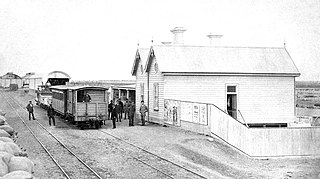
The railway station located at Port Pirie South bore the name "Port Pirie" from when it was built in 1876 until it was superseded in 1902 by a passenger station in the centre of Port Pirie. The new station was then assigned the name "Port Pirie railway station" and the original was named Port Pirie South railway station, in keeping with the naming of the adjacent Port Pirie South railway yards.
References
- ↑ Australian Railway History Australian Railway Historical Society
- ↑ Australasian Railway and Locomotive Historical Society (1937), Australasian Railway and Locomotive Historical Society : [bulletin], Australasian Railway and Locomotive Historical Society, retrieved 11 July 2023
- ↑ Australian Railway Historical Society (1952), Bulletin, Australian Railway Historical Society, ISSN 0005-0105
- ↑ Australian Railway Historical Society. New South Wales Division; Australian Railway Historical Society (2004), Australian railway history : bulletin of the Australian Railway Historical Society, Australian Railway Historical Society, New South Wales Division, ISSN 1449-6291